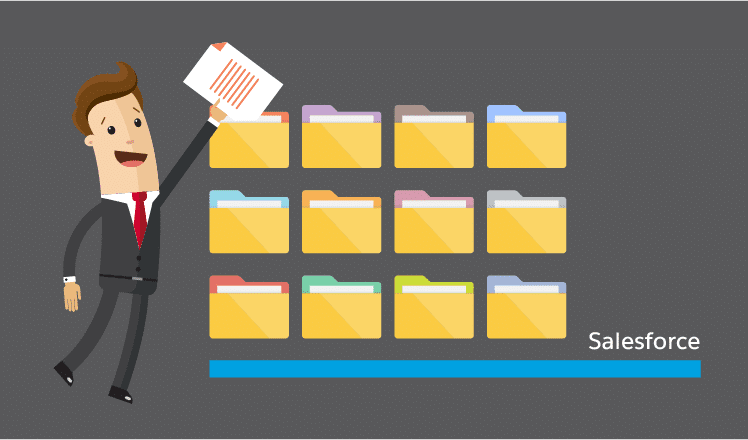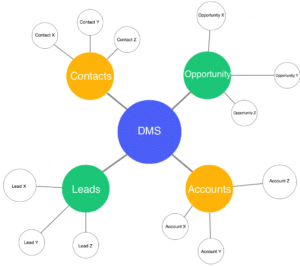In today’s fast-paced business landscape, efficient document management is a crucial aspect of maintaining a competitive edge. Salesforce, a leading customer relationship management (CRM) platform, offers robust solutions for document management, empowering organizations to enhance collaboration, streamline processes, and drive productivity. In this article, we will explore the key features and benefits of Salesforce Document Management, shedding light on how it can revolutionize the way businesses handle their documents.
Salesforce Document Management
Salesforce Document Management is a comprehensive set of tools and features designed to facilitate the creation, storage, sharing, and retrieval of documents within the platform. It integrates seamlessly with other Salesforce applications, providing users with a unified environment for managing both customer-related and internal documents.
Key Features
- Salesforce offers a centralized repository where users can store documents securely. This repository is easily accessible to authorized personnel, ensuring that the right people have access to the right documents at the right time.
- Maintaining version control is crucial in a collaborative environment. The system allows users to track and manage document versions effectively. This ensures that everyone is working with the latest and most accurate information, reducing the risk of errors.
- Enhanced collaboration is a hallmark of it. Users can collaborate on documents in real-time, making it easy to work together regardless of geographical locations. Comments, annotations, and discussions can be embedded directly within documents.
- One of the significant advantages of using Salesforce Document Management is its seamless integration with the Salesforce CRM platform. This integration allows users to associate documents with specific accounts, contacts, opportunities, or any other CRM records, creating a comprehensive view of customer interactions. Also check Salesforce Professional Services.
- Salesforce allows organizations to automate document-centric workflows, streamlining business processes. From document creation to approval processes, automation reduces manual intervention, minimizing errors, and speeding up overall operations.
Benefits of Salesforce Document Management
1. Increased Productivity
By providing a centralized and collaborative environment, Salesforce Document Management significantly enhances productivity. Team members can access, edit, and share documents without the need for extensive email exchanges or external file-sharing platforms.
2. Enhanced Security and Compliance
Salesforce takes data security seriously. With robust access controls, encryption, and audit trails, Salesforce Document Management ensures that sensitive information is protected. This is particularly important for businesses operating in regulated industries, where compliance with data protection laws is paramount.
3. Improved Customer Relationships
Integrating document management with the CRM platform enables organizations to have a 360-degree view of customer interactions. This holistic perspective helps in better understanding customer needs and delivering more personalized and effective services.
4. Cost Savings
The efficiency gained through streamlined document management translates into cost savings. Reduced manual handling, faster document retrieval, and minimized errors all contribute to a more cost-effective operation.
5. Scalability
As businesses grow, so does the volume of documents. It scales effortlessly, accommodating the increasing demands of a growing organization without compromising performance.
Implementation and Best Practices
Implementing Salesforce Document Management requires careful planning and consideration of best practices. Here are some key steps to ensure a successful implementation:
- Assessment of Document Types: Identify the types of documents your organization deals with and how they fit into existing processes.
- User Training: Provide comprehensive training to users to ensure they make the most of the document management features.
- Data Migration: If migrating from an existing system, plan and execute the migration carefully to avoid data loss or inconsistencies.
- Customization: Tailor Salesforce Document Management to your organization’s specific needs through customization and configuration.
- Regular Audits: Conduct regular audits to ensure that document access permissions align with organizational policies and compliance requirements.
How to Set Up Document Management in Salesforce
Setting up document management in Salesforce is a straightforward process. Begin by enabling Salesforce CRM Content or Salesforce Files, depending on your Salesforce version. Create libraries to organize documents and define permissions to control access. Integrate it with your existing workflows and train users on the new system. Regularly review and optimize your setup based on evolving business needs.
Effective document organization is vital for maximizing productivity. Establish a clear naming convention, create logical folder structures, and leverage metadata to categorize documents. Implement consistent tagging and labeling practices to simplify search and retrieval. Regularly audit and clean up outdated documents to maintain a streamlined and efficient document repository.
Integration Options
Salesforce offers seamless integration with various third-party document management systems. Evaluate integration options based on your organization’s specific needs and preferences. Choose a system that complements Salesforce, ensuring smooth data exchange and collaboration between the CRM and the document management platform.
Salesforce facilitates collaborative document sharing within and outside the organization. Leverage features like real-time editing, version control, and in-document commenting to enhance collaboration. Ensure that sharing settings align with security requirements, allowing teams to collaborate effectively while maintaining control over sensitive information.
Security Measures & Managing
Security is paramount in document management. Utilize Salesforce’s robust security features, including role-based access controls, encryption, and audit trails. Define clear access permissions and regularly review them to align with organizational changes. Educate users on security best practices to foster a culture of data protection.
Salesforce’s mobile accessibility empowers users to manage documents on the go. Ensure that your document management setup is mobile-friendly and supports various devices. This allows your workforce to access, edit, and share documents anytime, anywhere, promoting flexibility and productivity.
Addressing common issues in Salesforce Document Management requires a systematic approach. Establish a support system for users, regularly update the platform, and stay informed about Salesforce releases. Monitor user feedback and proactively address any issues, ensuring a smooth and reliable document management experience.
Future Trends
Keep an eye on emerging trends in document management within the Salesforce ecosystem. Explore advancements such as artificial intelligence for document categorization, enhanced collaboration features, and integrations with emerging technologies. Stay adaptable to future updates and innovations to continually improve document management practices.
Evaluate in comparison to other solutions in the market. Consider factors like integration capabilities, scalability, security features, and user experience. Choose the solution that aligns best with your organization’s requirements and offers a balance between functionality and ease of use.
Tips for Maximizing Productivity
To maximize productivity, encourage users to embrace features like document templates, automated workflows, and integrations with other Salesforce tools. Provide ongoing training to keep users informed about new features and best practices. Regularly assess and optimize your document management strategy to adapt to changing business needs.
Automation streamlines document workflows in Salesforce. Utilize workflow rules, process builder, and automation tools to reduce manual tasks and enhance efficiency. Map out your document workflows, identify areas for automation, and continuously refine them to align with evolving business processes. Automation not only saves time but also reduces the risk of errors in document management.
Conclusion
Salesforce Document Management emerges as a game-changer for businesses aiming to streamline their operations, enhance collaboration, and stay ahead in today’s competitive environment. By combining robust features, seamless integration with Salesforce CRM, and a focus on security and compliance, Salesforce empowers organizations to take control of their document-centric processes. As businesses continue to evolve, adopting modern document management solutions becomes not just a necessity but a strategic imperative for sustained success.












